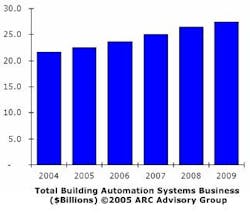Steady Growth Seen for Building Automation Systems
Steady growth in both developed and developing countries will push the worldwide market for Building Automation Systems (BAS) to more than $25 billion in 2009, up from less than $22 billion last year, according to a recent report from ARC Advisory Group Inc., Dedham, Mass. The firm expects the BAS market to expand at a compound annual growth rate of nearly 5 percent over the next five years.
“For companies in developed regions, strategic management of existing building assets [using BAS] is one of the best ways to increase productivity, with little to virtually no operational upsets,” says ARC Senior Analyst David Clayton, principal author of the report. “On the flip side, corporations in Asia continue expanding operations to meet growing domestic demand, many of which are incorporating state-of-the-art BAS solutions,” Clayton observes.
Convergence
The move toward increasing enterprise integration enhances the need for advanced BAS solutions. Companies across all vertical building markets are striving to increase integration across the entire enterprise to improve information management and optimize the strategic decision-making process. As BAS increasingly adopt IT standards, they are increasingly converging with traditional IT infrastructures, says the ARC study, titled “Building Automation Systems Worldwide Outlook.”
Integration between BAS and enterprise systems allows companies to optimize such applications as energy management and maintenance operations. For example, enterprise integration can optimize energy management by allowing energy management solutions to monitor utility rates in real-time and collect energy use over a group of buildings set apart geographically. Using the data, energy management solutions can analyze the enterprise’s energy portfolio and place certain building in a particular energy-saving mode based on real energy usage data and real-time energy rates.
Maintenance operations also benefit greatly from enterprise integrtion, the ARC report said, because it provides enterprise systems access to critical building parameters at the corporate level. This allows facilities managers to base critical strategic decisions on real-time, asset health information, as opposed to guesses and hunches. As more companies enhance their enterprise integration, they will increasingly invest in integrated BAS, ARC projects.
Off-the-shelf communication
Through the adoption of existing Internet standards for BAS data communication, suppliers have made it possible for BAS to communicate with enterprise systems using off-the-shelf technology already being employed in the majority of commercial and industrial buildings today. With the adoption of Internet communication standards, such as Ethernet, transmission control protocol/Internet protocol (TCP/IP), Web servers and Extensible Markup Language (XML), the price of integration BAS with existing enterprise systems is lowered dramatically because the level of customization necessary is reduced.
Adoption of IT standards in the BAS industry, and the inherent cost savings with BAS integration, according to ARC, is causing many building owners to rethink the value proposition of integrated BAS.

